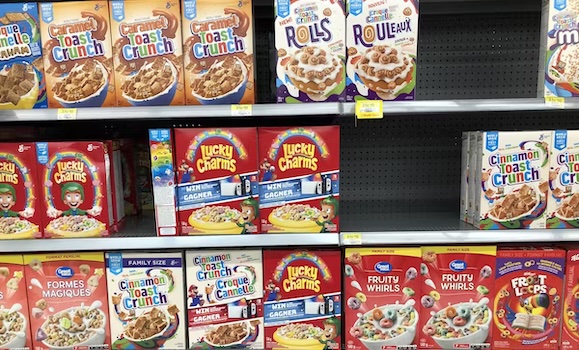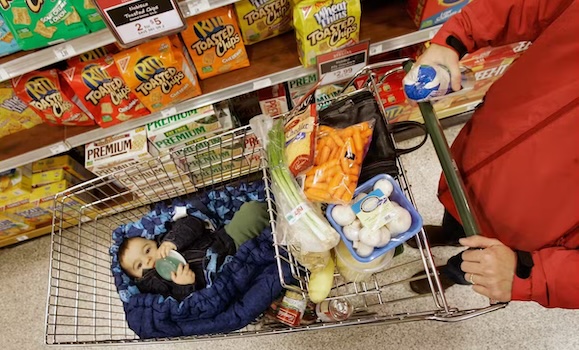◊Ó–¬–”∞…‘≠¥¥ the author: Ã˝is a Professor of Health Promotion; Scientific Director of the Healthy Populations Institute atÃ˝Ã˝≤π≤‘ªÂÃ˝Ã˝is aÃ˝Canada Research Chair in Healthy Food Policy, Assistant Professor in Nutrition at theÃ˝.
Ã˝
Healthy eating sounds deceptively simple — just eat more fruits and vegetables and avoid junk food, right? However, healthy eating really isn’t easy.
illustrates how ubiquitous unhealthy foods are, how aggressively they are promoted and how hard it is to access healthy foods in places we spend our time.
We are part of a team of 18 nutrition and food policy experts from across Canada who looked at research from the past five years to expose the environmental factors that influence what people in Canada buy and eat. We explored many different factors, like the quality of food, food marketing practices and what foods are available in places like hospitals, schools and grocery stores.
The report is part of an international network called (International Network for Food and Obesity/Non-communicable Diseases (NCDs) Research, Monitoring and Action Support). Our findings reinforce that, from homes to hospitals, Canada’s food supply needs reform.
What we see is what we get
Ã˝Ã˝
Unhealthy food is everywhere, and that makes it hard to avoid: what we see is what we get. Our report found that most packaged foods in grocery stores are unhealthy. In fact, two-thirds of them were high in salt, sugar or saturated fat. Only 12 per cent were low in these nutrients.

Breakfast cereals often use marketing techniques that made products look fun or cool, or cartoon characters and celebrities, to entice young consumers.Ã˝THE CANADIAN PRESS/Richard Buchan
Unhealthy foods are readily available for purchase. One study showed that children in Ottawa had, on average, 19 places to purchase foods within one kilometre of their school. In Vancouver, that number was as high as 45.
In-store environments also thwart healthy purchases: of candy, snacks and sugary drinks, tempting consumers at the checkout, while only around one in five stores operated a junk-free checkout. And nearly all hospital cafeterias and recreation centre vending machines sold sugary drinks.
Unhealthy foods are also heavily marketed, particularly to children. estimated that children aged six to 11 see more than 4,000 food ads on their digital devices each year, while older children see twice that number. Around 90 per cent of the ads that children saw on their digital devices were deemed less healthy based on their sugar, sodium and saturated fat content.
A closer look at marketing on five food product categories in the found that one-third of products carried marketing targeting to children.
For example, almost 46 per cent of breakfast cereals used marketing techniques that made products look fun or cool, or used cartoon characters and celebrities, to entice young consumers. More than 90 per cent of products using these techniques were unhealthy. Of 75 per cent of foods that had some sort of health or nutrition claim on their packaging highlighting healthy attributes of products, 45 per cent of these products were also high in salt, sugar or saturated fat.
Unhealthy foods are big, cheap and easy
Ã˝Ã˝
Our report illustrates how, in many ways, the cards are stacked against us in terms of healthy eating. The food industry, , continues to create and market unhealthy foods, despite stated commitments to do better.
With unhealthy foods so available and tempting, it’s no surprise that many Canadians struggle to eat according to .

With unhealthy foods so available and tempting, it‚Äôs no surprise that many Canadians struggle to eat according to Canada‚Äôs Food Guide.Ã˝(AP Photo/Amy Sancetta, file)
Our unhealthy food environments are making us sick and we all pay the price. , including direct healthcare costs of $5.9 billion. With unhealthy eating a , there is a strong moral and economic imperative for action to improve food environments.
Creating healthier food environments
Ã˝Ã˝
It doesn’t have to be this way. In addition to providing benchmarking data, our report offers a road map for policymakers, industry leaders and advocates to collaborate in creating healthier, more equitable food environments for all Canadians.
Canada can also draw inspiration from global leaders in food policy like and . Both countries have introduced bold front-of-package warning labels for foods high in sugar, sodium or saturated fats, combined with restrictions on marketing unhealthy products to children and taxes on unhealthy foods.
Canada will follow suit with front-of-package labels in January 2026, but policy change in these others areas is lacking.
, with the United Kingdom recently seeing after a sugary drink tax was implemented. Canada, unfortunately, is lagging behind, with the only province with a tax on sugary drinks.
As Canada’s rolls out, there are opportunities to . These actions need to be extended to other food environments — our homes, hospitals and grocery stores.
With the threat of tariffs being imposed by the United States and , more Canadians are looking for a food supply that is made in Canada. Creating healthier food environments and food systems takes a strong commitment from leaders at all levels (federal, provincial, territorial and municipal).
Above: Mexico has implemented front-of-package food label regulations flagging unhealthy foods. Canada will follow suit in 2026.Ã˝(Shutterstock)
Our benchmarking report can help create a nutrition transition that nourishes our population and supports our healthy food producers, farmers and fisheries. This report makes the case for improving our food environments and shows the way to a healthier future for all Canadians.![]()
This article is republished from under a Creative Commons license. Read the .

